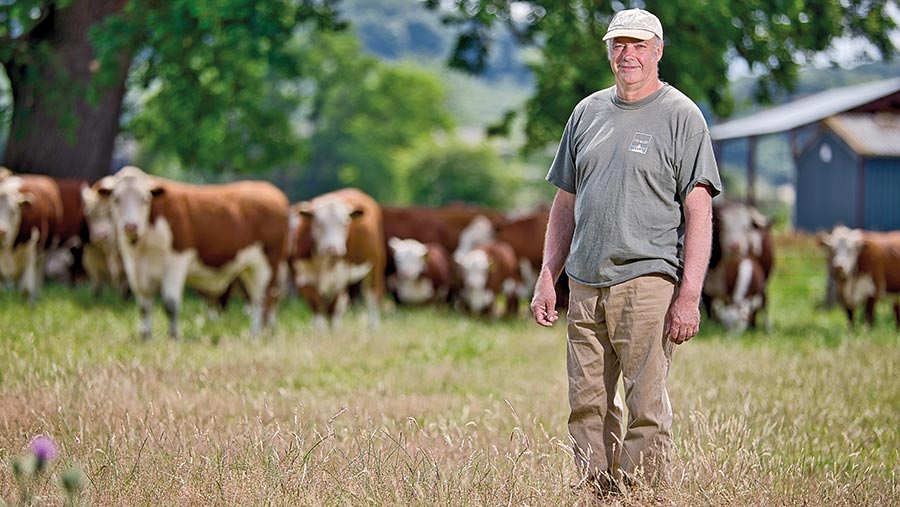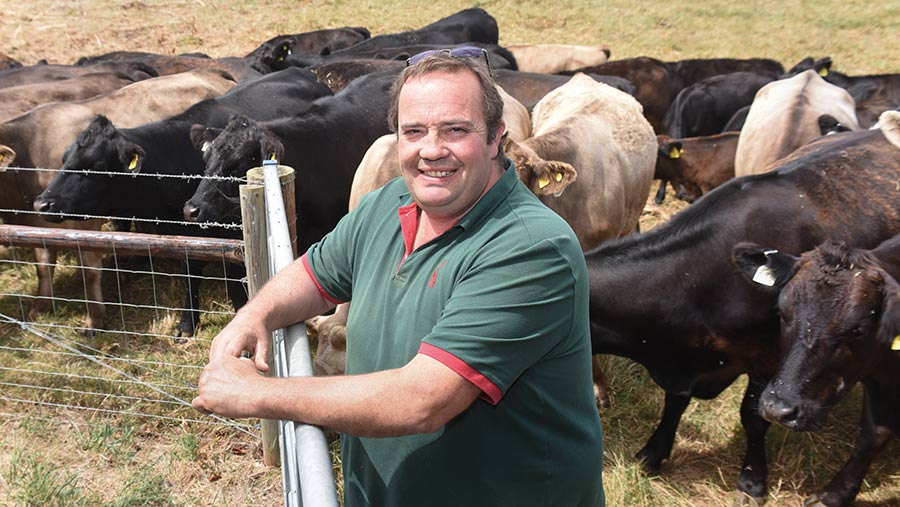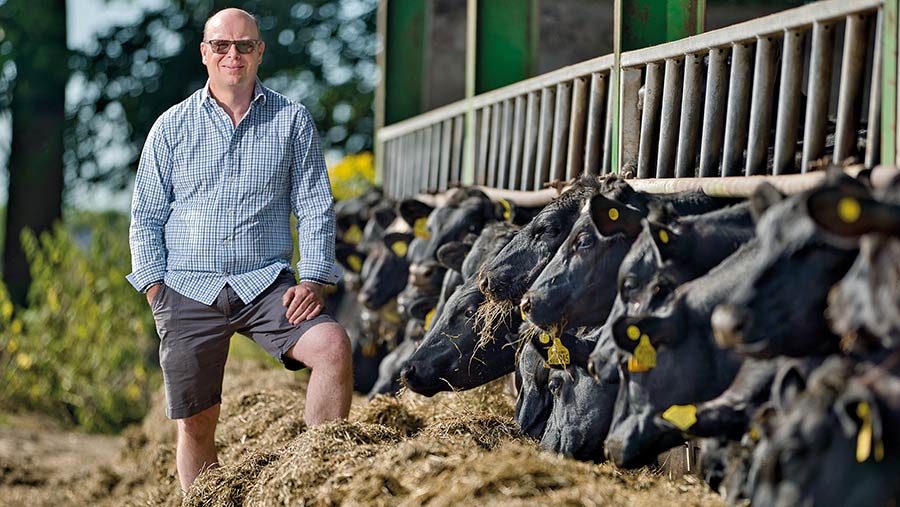Farmers Weekly Awards 2022: Beef Farmer of the Year finalists

Home-grown feed, including drought-tolerant lucerne for protein, gives the three finalists for the Farmers Weekly Beef Farmer of the Year Award a head start in resilience.
While production systems vary, they all have a strong focus on health and welfare and their customers’ needs.
See also: Farmers Weekly Awards 2022: Young Farmer of the Year finalists
The finalists:
Simon Cutter
Model Farm, Hildersley, Herefordshire
Edward Hulme
Merton Farm, Canterbury, Kent
James Stafford
Pickwick Lodge Farm, Corsham, Wiltshire
The judges:
Aled Evans
Last year’s winner (with brother Iwan)
Judith Tooth
Farmers Weekly acting livestock editor
Ian Cairns
Independent consultant with 5Agri Consultancy Group
Simon Cutter
Model Farm, Hildersley, Herefordshire

© Richard Stanton
Simon Cutter farms the last remaining county council holding in Herefordshire. At Model Farm, he has developed a low-cost suckler beef enterprise as part of a diverse, fertility-building crop rotation.
He runs a split-block calving system for his herd of pedigree Poll Hereford cows. Year-round finishing ensures a consistent supply of beef for the farm’s butchery and shop.
Two animals are slaughtered each week at 24 months, with a target weight of 620kg liveweight off forage only.
A founder member of the Pasture-Fed Livestock Association (PFLA), Simon farms to organic and PFLA standards.
Production system
In the early days of the farm’s Higher Level Stewardship scheme, now 20 years old, he got a derogation to outwinter and bale-graze his cows to reduce cow maintenance costs.
“Everyone thought I was totally loopy, but starting from nothing it was the only way I could do it,” he says.
The herd is part of Scotland’s Rural College’s premium cattle health scheme. Breedplan is used for herd recording and to maximise the traits available in a major breed, says Simon.
While he retains some of the last remaining British Poll Herefords, his focus is on New Zealand genetics, which have been “a revelation” in terms of improved performance off grass.
Simon uses estimated breeding values (EBVs) to drive improvements in the herd. Having successfully selected for maternal placidity, calving ease and longevity – cows have at least eight calves – the focus now is improving marbling and eye muscle from forage-type bulls.
As well as grass, grazed rotationally, and clover-rich herbal leys, lucerne is grown for protein and to counter drought.
Simon takes three to four cuts a year, which are clamped in alternating layers with an arable silage of oats, barley, peas and vetch.
Woodchip, supplied free from local landscape gardeners, is spread in the finishing shed at the start of winter.
Simon buys in straw for bedding, which is then composted with the woodchip before spreading in the first year of the crop rotation.
Performance
Annual beef costings are £202 a cow, including 120 days of winter feeding on hay and deferred grazing with young calves, at 40p/day. Producing a 300kg weaned calf is costed at £243.
Once this is added to second-year costs, a finished autumn-born calf costs £404 to produce, and a spring-born one, £492, plus Simon’s time.
The business employs two full-time butchers and specialises in supplying beef for customers following “stone-age” and “keto” diets, which favour grass-fed meat, as well as those interested more generally in a high-quality product.
Beef is sold online through Primal Meats and Back to Nature, via a local box delivery scheme, or at the farm’s shop attached to the butchery cutting room. Bones for broth are sold at £5/kg, while fillet steak costs £35/kg.
Simon’s two sons, George and Jonty, look after marketing and delivery runs.
Future plans
Renting more land enabled Simon to build the suckler herd to 110 cows. Now ready to reduce his workload, he has spent the past year mentoring local farmers Kitty Stainsby and James Smith.
He recently sold 40 cows, 10 in-calf heifers and followers to the landlord Simon rents his land from. The landlord now employs the couple to look after the livestock.
“Hopefully, the young brains will take forward what I began,” says Simon, whose focus now is on breeding bulls from a smaller herd.
What the judges say
Simon Cutter is a pioneering and innovative farmer who knows the nutritional value of his pasture-fed beef, and has developed a farm system to meet demand for it.
Simon Cutter summary
The judges liked
- Innovative and enthusiastic approach
- Passionate about using EBVs
- Adding value with butchery business and farm shop
- Mentoring of new entrants into farming
- Close engagement with local community and beef customers
Farm facts
- Tenant farmer on 142ha (350 acres): 81ha (200 acres) county council holding, plus 61ha (150 acres) of various land parcels
- Organic, pasture-fed system
- Pedigree Polled Herefords, Easycare ewes and a small herd of sows
- Butchery and farm shop
- Silage and hay made by local contractors Philip and Gareth Watkins
The numbers
- 20 Distance in miles from abattoir in Stroud
- £4.10 Current price/kg butchery pays beef enterprise
- 8 Length of rotation in years. Crops include potatoes and artichokes sold off farm, and stubble turnips undersown in cereals grown for arable silage
- 44 Dry matter yield (t/ha) from three to four cuts of lucerne/year
- 600 Average weight (kg) of Hereford cow at Model Farm
Edward Hulme
Merton Farm, Canterbury, Kent

© Hugh Nutt
Edward Hulme runs 400 spring-calving suckler cows on an extensive grazing system across 486ha (1,200 acres) on the home farm and the Kent coast.
This integrates well with the family’s arable and fruit enterprises, supplying muck from winter housing to improve arable yields, and using waste from the packhouse in beef rations.
The farm makes plenty of hay for the cows and feeds entirely home-grown rations for housed stores and finishers.
Since switching from Charolais to mainly Aberdeen Angus, finishing age has been reduced from 24-29 months to 17-20 months. Most cattle are supplied to Waitrose via Dovecote Park.
Production system
Cattle are wintered in straw barns. Heifers calve on permanent pasture near the farm, while cows calve indoors before moving out to one of nine 2.4ha (6-acre) paddocks, each with 38 cows and calves.
They then move to extensive grazing at Folkestone and Sandwich Bay, some of it very marginal.
Edward follows a comprehensive vaccination policy, and all cows are given boluses twice-yearly for trace elements and vitamins.
He selects hard for fertility and has established a tight calving block, with heifers calving by 14 March, all within eight days, and cows from 25 March to 18 May.
Hip-scoring of heifers has reduced complications at calving. Edward says the pelvic area must measure at least 150sq cm, and the heifer must then get in-calf within 30 days, to be kept for breeding.
Bulls, bought from the Warren Ho herd, are used for every 25 cows, with up to seven in each group.
Fence-line weaning begins in November, after which youngstock move indoors into straw yards. Cows are in by December.
Rations, home-grown except for limestone flour, are formulated with guidance from independent nutritionist David Hendy.
Lucerne – ideal for growing on sub-optimal arable ground – helps keep costs down, producing 49t/ha freshweight from four cuts. Fruit rejected at the farm’s packhouse is also used, and double-cropping triticale and maize improves efficiency.
Finishing rations comprise maize silage, forage triticale, lucerne (ground to avoid wastage), ground straw, “the barest squeak” of grain – which, this year, is maize grain – and limestone flour.
Most finished cattle are supplied to Waitrose via Dovecote Park, with the remaining 10-15% going to family-run abattoir Pickstock Telford.
Performance
Edward says this year’s calving is the best it has ever been: 43 calves from 46 heifers, and 382 calves from 386 cows. On average, each cow has nine calves, with first calving at 23 months.
Finishers leave the farm aged 17-20 months. Edward prefers to select by eye rather than weighing, and deadweights are consistent, at 331kg for steers and 291kg for heifers.
Rations are costed at £1.46 for stores and early finishing rations, rising to £1.70 a day for finishers, plus 18-20p for diesel and tyres.
On the farm with Edward are foreman Daniel Baldock, Simon Kemp and Jonah Williams.
Future plans
Within three years, the herd will be all Aberdeen Angus-sired to make it eligible for a Waitrose premium and to help reduce maternal cow weight to a target 650kg.
Edward aims to use more artificial insemination (AI) using home-saved semen.
This year sees the first two heifers in-calf to bulls using embryo transfer from North Dakota outfit Schaff Angus Valley. He would also like to increase cow numbers to 500.
What the judges say
Edward Hulme has an infectious enthusiasm for producing top-quality beef from his suckler-finisher herd. He is continually striving to make further improvements, and values input from his vet and nutritionist.”
Edward Hulme summary
The judges liked
- Commitment to high-welfare beef production
- Home-grown rations benefiting beef and arable enterprises
- Success at improving herd fertility
- Willingness to learn from industry experts
- Focus on meeting demands of meat processors
Farm facts
- 1,528ha of owned and tenanted land and grazing licences
- Closed herd of 400 suckler cows
- 1,108ha in environmental schemes
- Arable rotation includes wheat, barley, beans, grass seed and 22ha lucerne
- Major fruit business with 202ha of apple and pear orchards plus packhouse
The numbers
- 23 Average age in months at first calving
- 25 Number of cows with each bull
- 650 Target cow weight in kgs
- 3 Number of heifers taking to artificial insemination this year, out of 46
- 1 Number of miles the farm is from Canterbury
James Stafford
Pickwick Lodge Farm, Corsham, Wiltshire

© Richard Stanton
James Stafford has developed a forward store and finishing beef system that is a great fit with the family farm’s arable operation.
He buys in weaned dairy-beef calves, mainly heifers, housing them on 90% home-grown feed, and provides valuable muck for the arable land in exchange for straw for bedding.
Indoor housing is easy to cost and takes less time than the previous grazing system – one-and-a-half hours feeding in the morning, and the job’s done, says James.
Improved forage management has resulted in better quality silage and improved cattle growth rates, which are maintained by regular monitoring of feed rations.
Production system
James switched to an indoor system after grazing heifers on silage aftermaths proved impractical because of the farm’s location either side of Corsham.
Now, calves are bought from Meadow Quality’s rearing centre in Chippenham in even batches of 35, which suits the capacity of the cattle sheds.
James is also trying out some Angus-crosses to benefit from an Angus premium of up to 30p/kg.
Calf health on farm has improved significantly since buying calves at 130kg liveweight, rather than 100kg. James pays £400 a head, including all vaccines, plus a rearing fee of £180.
Following earlier issues with pneumonia, medicated cake is fed for the first 14 days to prevent coccidiosis. This starter ration is followed by a coarse mix transition diet for 20 days.
Cattle then move on to a total mixed ration of home-grown rolled barley, arable and grass silage, and lucerne, plus a small amount of bought-in protein. Lucerne is a “tremendous” crop, and the cattle love it, says James.
A good break is needed between crops, however, and he is planning a switch to herbal leys under the farm’s new Countryside Stewardship agreement.
Rations and feed prices are reviewed regularly using Farmplan Cattle Manager. An electronic identification and weighing system, linked to Farmplan, has been adopted, with the help of grant funding.
This has improved the selection process of cattle for slaughter.
Two-year Italian ryegrass leys have been brought into the arable rotation, and replacing one big silage cut in early June with three cuts has improved forage quality.
The grass responds well to applications of biosolids, and this, along with a lot of cattle muck, has helped cut use of bought-in nitrogen fertiliser.
Performance
Better silage quality has also led to an increase in cattle growth rates, reducing age at finishing. At 17 months, continental-crosses weigh 520kg on average, when they are transferred to a finishing diet.
James is seeing growth rates of 0.9kg a head a day, rising to 1.49kg a head a day during the finishing stage. The most recent batch of finished cattle averaged 511 days on farm.
Average margin a head is £125-£130, including fixed costs. Meadow Quality or Frome Market are the most likely outlets for stores, while ABP takes most finishers, along with local abattoir Alec Jarrett.
Farmworker Nick Stevens assists on the farm on a self-employed basis, looking after the machinery and helping with the cattle at least one day a week.
He is a “a godsend” who has taken the pressure off James since his father, Guy, died two years ago.
Future plans
James sees a big future for dairy-beef, and has his sights set expanding cattle numbers by a further 100-head. A new covered straw shed is planned this winter, as muck is so valuable to the arable rotation.
What the judges say
James Stafford’s drive to improve all aspects of his dairy-beef unit, from forage quality to finishing times, is impressive, and the system fits hand in glove with the farm’s arable cropping
James Stafford summary
The judges liked
- Complementary beef and arable systems
- Use of home-grown feeds
- Attention to detail
- Commitment to continual improvement of system
- Use of technology to improve efficiency and inform decision-making
Farm facts
- 240ha of owned, rented and contracted land
- 250 continental- and Angus-cross cattle, mainly heifers
- Arable rotation of wheat, winter and spring barley, oilseed rape and grass leys
- Farmhouse bed and breakfast run by James’s mother, Gill
- Cattle sheds sit above an underground “city” code-named Burlington Bunker, centre of UK military communications during the Cold War
The numbers
- 15 Number of years lucerne has been grown on the farm for protein
- 475 Weight (kg) of Angus-cross heifers at 17 months
- 24 Maximum age of cattle in months at slaughter
- 3-4 Age of calves in months on arrival at farm
- 511 Average number of days finishing cattle spend on farm

